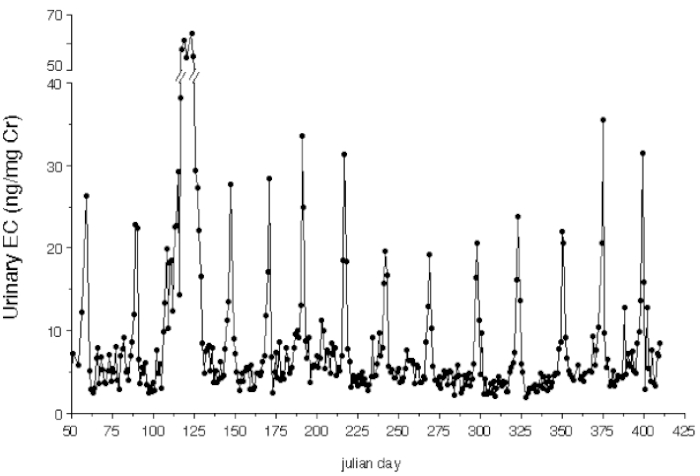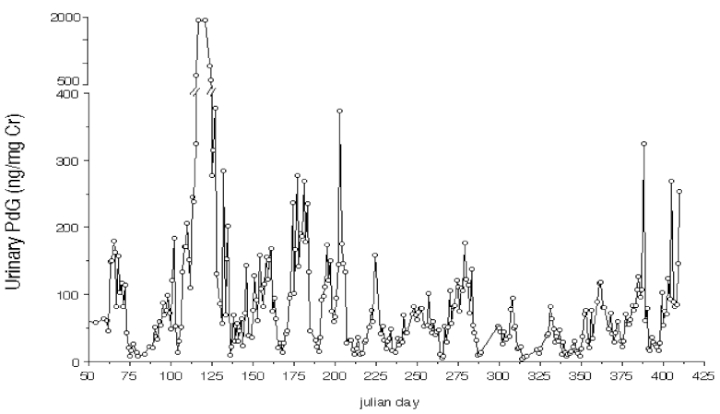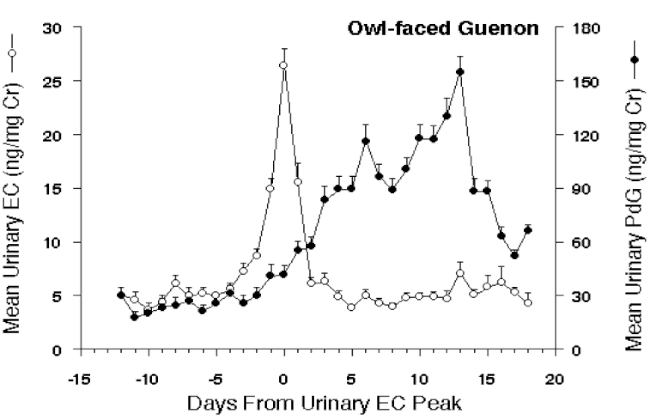Year-Round Urinary Ovarian Steroid Monitoring in a Clinically Healthy Captive Owl-Faced Guenon (Cercopithecus hamlyni)
Abstract
Owl-faced or Hamlyn’s guenons (Cercopithecus hamlyni) are native to eastern Zaire and Rwanda. Limited information is available regarding the natural history of this species in the wild. Field observations of other cercopithecine species provide some evidence for reproductive seasonality, although breeding may occur year-round in some wild populations.1 As of December 1996, the international zoologic population of owl-faced guenons included 55 (14.37.4) animals in 14 International Species Information System (ISIS) institutions.2 Despite their relative abundance in captivity, little published information exists describing their captive management, and there are no reports describing the reproductive biology of this species.
In May 1994, the Philadelphia Zoo received two male owl-faced guenons (one adult, one subadult) from an ISIS institution. In June 1994, the zoo received an adult female from a second ISIS institution. For 14 days following the female’s arrival, the males remained physically isolated, but had visual, auditory, and olfactory contact. Immediately following physical introduction and for a period of approximately 6 hours thereafter, both males repeatedly copulated with the female. The three animals were housed together for 3 months, after which the subadult was separated from the group. During the 7 months subsequent to initial introduction, no copulatory behaviors were observed, and the female exhibited no physical signs of ovarian activity (e.g., changes in perineal skin color or profile; overt menses). Physical examinations were performed on each of the animals in June and October 1994. The adult male was not ejaculated, nor was invasive reproductive examination performed upon the female. Physical, hematologic and serum chemical findings were unremarkable.
A longitudinal examination of urinary ovarian steroid metabolites was undertaken to 1) determine if the female was exhibiting ovarian cyclicity, and 2) characterize the basic features of the female reproductive-endocrine cycle. Freshly voided urine samples (1–5 ml) were collected daily over a 12-month interval and stored frozen until analysis. Hormone determinations were performed at the Conservation and Research Center’s Endocrine Research Laboratory, Front Royal, Virginia. Urinary estrogen conjugates (EC) and pregnanediol-3-glucuronide (PdG) were analyzed as described previously;3 both assays were validated for use in owl-faced guenons. All urine samples were indexed by creatinine (Cr) measurement,3 and hormone values were expressed as mass units/mg Cr excreted. The female became pregnant during the study but experienced a first-trimester abortion.
Longitudinal measurement of steroid metabolite excretion revealed that this female exhibited spontaneous year-round ovarian cycles with no evidence of reproductive seasonality. The overall mean nonconceptive ovarian cycle duration was 25.4±2.5 days (n=12 cycles; range 20–29 days), whereas the mean luteal and follicular phase durations were 15.3±1.1 days and 10.6±3.2 days, respectively. During nonconceptive cycles, EC concentrations increased approximately sevenfold over baseline follicular phase levels (3.96±0.85 ng/mg Cr) to midcycle preovulatory peaks (26.36±5.27 ng/mg Cr) and declined rapidly thereafter to basal concentrations (Figure 1). Urinary PdG concentrations remained low during the follicular phase (22.72±9.51 ng/mg Cr) but rose rapidly around the time of the preovulatory EC peak (Figure 2). Peak luteal PdG concentrations (192.93±88.11 ng/mg Cr) were achieved 5–10 days following midcycle EC peak and exceeded basal concentrations by approximately ninefold (Figure 3). During early pregnancy, both EC and PdG concentrations increased (EC, 16-fold; PdG, 100-fold) over follicular-phase concentrations; a rapid decline in both metabolites reflected an abortion during the first trimester of pregnancy.
Figure 1. Urinary estrogen conjugates in a clinically healthy, female owl-faced guenon

The EC profile on approximate Julian days 110 to 135 was concurrent with pregnancy and spontaneous abortion.
Figure 2. Urinary pregnanediol-3-glucuronide in a clinically healthy, female owl-faced guenon

The EC profile on approximate Julian days 110 to 135 was concurrent with pregnancy and spontaneous abortion.
Figure 3. Mean ovarian cycle profile (over 1 year) of a clinically healthy, female owl-faced guenon

Data points recorded during pregnancy and abortion in this animal were excluded for mean ovarian cycle determination.
The general endocrine profiles of urinary EC and PdG provide an accurate representation of ovarian function, including the diagnosis of pregnancy and abortion, in the owl-faced guenon. Caution must be exercised in applying the data presented herein to other owl-faced guenons. Urine assays performed on other captive owl-faced guenons would substantially supplement this data set.
Literature Cited
1. Nowak, R.M. and J.L. Paradiso. 1983. Walker’s Mammals of the World, 4th ed. Baltimore: Johns Hopkins University Press, Pp. 409–411.
2. International Species Information System. 31 December 96. ISIS Mammal Abstract. Apple Valley, MN: International Species Identification System, p. 60.
3. Monfort, S.L., C. Wemmer, T.H. Kepler, M. Bush, and J.I. Brown. 1990. Monitoring ovarian function and pregnancy in Eld’s deer (Cervus eldi thamin) by evaluating urinary steroid metabolite excretion. J. Reprod. Fertil. 88:271–281.